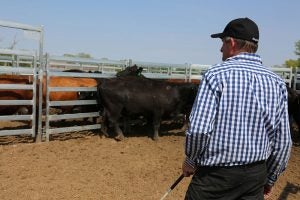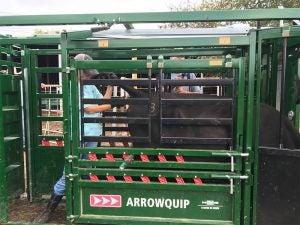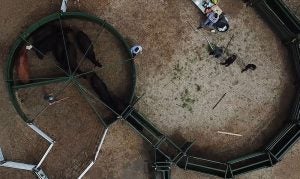It is the end of another long day on a beef cattle operation. The handlers are working the last group of cattle through the cattle chute. The cattle equipment is older, and patched together in places. A heifer enters the chute. It is too big for her, but the handlers try and make it work. Disaster strikes. One of the handlers is crushed into the wall by the heifer as she turns around in the cattle chute trying to escape.
Cattle are responsible for 22 U.S. deaths per year, according to the Centers for Disease Control and Prevention. In Canada, there were 65 fatalities with animals from 2012 to 2016 — half caused by cattle. In Ireland, livestock are responsible for 42 percent of farm injuries, with 18 deaths caused by cattle between 2009 and 2018.
Experts agree that risk of injury or death is higher when: handling cattle in equipment, herding or moving cattle, loading cattle, and feeding. When these are all practices we conduct on a routine basis, will you become a part of these sobering statistics?

Low-quality cattle equipment drives risks higher with broken arms, dislocated shoulders, pinched fingers, and more. Another report states that up to 24 percent of livestock handlers are injured every year, and 47 percent, of the injuries were caused by improper facilities. Lowering this statistic could be done easily by prioritizing safety and preventive measures.
No one should become a statistic, and as an industry we can do better.
Operations settle for low-quality equipment because of three common reasons: 1) it is cheaper, 2) they did not research all options, or 3) they built their own. However, danger lurks in many areas of cattle equipment if it is improperly designed.
- Tubs: A common injury in cattle tubs is handlers being crushed by the crowd gate, causing bruises, broken ribs, or even death. Poorly manufactured equipment is more likely to have broken panels or gates that do not latch correctly. Legs break falling from a panel, and hands can be crushed trying to force a gate closed. When evaluating various cattle tub designs, consider features that prevent the situations mentioned from happening, such as crowd gate lock-stops to keep cattle from pushing back.
- Alleys have similar risks to tubs since cattle are subject to a narrow, confined space. To eliminate chances of being stepped on or crushed by the herd, handlers should avoid being in the alleyway with cattle as much as possible, even when working calves. For added safety while remaining efficient, choose cattle alleys that allow you to easily manage cattle flow using low-stress cattle handling techniques, reducing the need to reach in and prompt cattle.
- Chutes for cattle have the greatest risk of injury for handlers. When the animal is trapped and separated from the herd, their fight or flight response can be triggered. Unacclimated cattle have higher chances of exhibiting aggressive behavior when in the chute. They will pull back against the head gate, move side to side, or even go down. Additionally, many cattle kick as they are approached from the rear. Releasing an animal from a poorly maintained cattle chute can also be a disaster. With high chances of the head gate ceasing with an animal in it, the handler can risk losing a finger or two when attempting to release it.

Amanda Sears of Crazy A Breeding Services shares her experience with high and low-quality cattle chutes.
“While working with other cattle chutes, I have been injured due to their poor design. I had my shoulder dislocated while palpating in a regular chute with drop down sides. You would think the V shape in standard chutes for cattle would help squeeze the animal down by conforming to the animals’ body, but the straight up and down parallel squeeze chute immobilizes the animal better. They say cows cannot kick straight back but I can assure you a mad momma can do the ‘impossible.’ Being able to squeeze down on that animal that much tighter also prevents them from getting a good swing when they do kick.
The butt bar is rarely in when I’m behind them due to an incident I had with a heifer that was not squeezed down properly throwing herself down and me almost busting my arm because I couldn’t pull my arm out fast enough (she was a shorter heifer so the bar was very close to my arm). Some chutes allow you to notch the butt bar forward with your leg when you are behind them and it cannot come back and hit you. It also cannot go flying up and hit your arm or come out when they kick due to the top rail holding it in place.”
Find a cattle chute that features a durable squeeze mechanism that can be easily adjusted depending on the size of cattle. Applying a tight squeeze pressure will help keep cattle calm. For added security, make use of sternum and rump bars to prevent cattle from going down or kicking.

Play it safe: Avoiding injury
You can avoid cattle handling injuries by applying low-stress cattle-handling techniques, focusing on safety features in equipment, and using common sense. Investing in quality equipment saves you tenfold in hospital trips, missed work, and unexpected expenses. Complete the following assessment before using your cattle system again:
- How safe is it?
- Are all parts in good working order? Was it assembled using manufacturer guidelines?
- Was it designed for the job? Injections require different access points than ear tags. What jobs will it be used for?
Consider upgrading your cattle equipment if you are not 100 percent confident in your answers.
Other factors that increase safety when working with cattle include:
- Understanding animal behavior
- Having escape routes planned out
- Keeping a first-aid kit nearby
- Ensuring protection through insurance
- Never working with cattle when frustrated or angry
As livestock handlers, we must remain vigilant at all times about safety on our operations, from the equipment we use to the handling methods chosen for cattle. No one should be a statistic. Together, we can decrease the number of injuries and deaths caused by livestock and equipment.
For more content on cattle equipment, handling, and safety, visit arrowquip.com/blog.
References
Are you Struggling with Cattle Handling?
Cattle Handling and Working Facilities
Farm Injury/Fatality Statistics in Canada
Farm Safety Check: Livestock Facilities & Handling Safety
Fatalities Caused by Cattle – Four States, 2003-2008
‘I ran as hard as I could, she charged after me’: Farmer attacked by cow speaks out about farm safety
Low Stress Cattle Handling for Productivity and Safety
Prevent Injury When Working With Cattle This Spring
Shark Versus Cow: Which is Deadlier?
Working Safely With Livestock
This article was published on behalf of Arrowquip.


